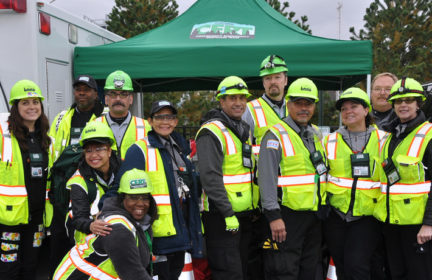Book Review: “Deep Survival” – Who Lives, Who Dies, and Why
(image credit: “mountains” by Enrico Strocchi is licensed under Creative Commons – CC BY-SA 2.0)
“Deep Survival” by Laurence Gonzales
If you’re looking for a book that explains strategy and tactics to build mental resilience and make it through tough events, this is a good one. I’ll cover the highlights so you can get started.
Laurence Gonzales is a pilot and journalist who has spent several decades writing about risk and survival. He has read thousands of accident reports, and has interviewed experts from many fields that involve danger, risk assessment, and staying calm under pressure: fighter pilots, firefighters, mountain climbers, wilderness rescue guides. “Deep Survival” is his synthesized analysis of: Why do some people beat the odds and survive?
Part 1: Mental Models and Why We Fail
In Part 1 Gonzales outlines how accidents happen – how our brains work to create mental maps and models of the world, and when these can be right and wrong. He notes when the world can become too complex for humans to understand, and several failure modes that cause us to make mistakes – making assumptions, not updating our mental map when something changes.
The top skill for survival is self-control, and the ability to stay calm. Staying calm helps us to perceive and act clearly rather than rashly. Laughter helps with this. Laughing makes the feeling of being threatened more manageable. It also spreads quickly and unconsciously between people. When you laugh you can feel more relaxed, which helps you to stay calm and focus.
Gonzales discusses our brain’s ability to create “emotional bookmarks” – shortcuts to skip to and perform a certain action without thinking, so it is able to act faster. This can be both good or bad – if your brain has bookmarked the correct action or a harmful action – e.g. removing your breathing regulator while diving. This is why practicing skills helps so much – your body can learn how and when to take the correct action even – or especially – when you’re not thinking. Often this can mean the difference between success and failure.
Another problem getting in the way of survival is not being open to new information or changes. A survivor must expect the world to keep changing, and keep their senses attuned to “What’s up?”. You have to be able to keep processing new information about the world, and let it inform your mental model. Being actively curious helps with this.
When in doubt: don’t.
The last topic Gonzales covers is knowing how to read your environment, and how to react if things get unsafe. You want to learn and build a general understanding of the systems, world, or tools you are working with, and need to be able to recognize and admit when the environment is too large, or too complex. You might be right on the boundary edge of failure and danger, but not realize it. Humans tend to let their guard down when we think we have reached our goal. It is easy to be fooled and think we have things under control.
His overall assessment: “The most efficient preparation is general physical, mental, and professional readiness nurtured over years of training and experience”.
Part 2: Useful Tactics to Think, Act, and Survive
Some people are better at updating their mental model than others. They’re called survivors.
Gonzales spends seven chapters detailing tactics, attitudes, and mental tools used by successful survivors to persevere and get through their situation.
The most important skill is keeping an up-to-date mental map of the current situation or environment. If we are not able to create a mental map, our brain treats this as an emergency, and triggers a physical and emotional response. “Being lost is not a location; .. it is a failure of the mind”. Training and practice beforehand help with this, as we better understand the systems and environment.
Gonzales discusses the importance of quickly moving to the “Acceptance” stage in any situation, so you can avoid wasting time denying reality, and focus on calm, forward progress. “Perceive, believe, then act”. The best survivors spend almost no time getting upset about what has been lost, or feeling distressed about things going badly. They take charge of things within their power, and leave the rest behind. They usually don’t take themselves too seriously, and are therefore hard to threaten.
A large part of maintaining the correct mental model is being open to new possibilities and change. Gonzales covers keeping a humble “beginner’s mindset” and developing “active passiveness”: the ability to accept the situation you are in without giving in to it. Several stories demonstrate how survivors commonly experience a bit of split personality that separates out the emotion from simply focusing on the task at hand. They can skip fully processing or worrying about the events until later, once they are safe. Often this helps to be slow and calm, and think through scenarios before acting rashly.
The book is threaded with solid, real-life examples of survivors getting into and out of tough spots, with stories of their mental process. Whether it’s a mountain climber breaking their leg at 19,000 feet, yet being able to separate emotion and repeatedly take small, correct actions to return; or a river rafting guide having enough experience and wisdom to recognize when conditions got too dangerous and say “No, not today”, saving the life of their group while two other parties perished. The stories are gripping and informative.
Gonzales concludes with a powerful synthesis summary of two lists: How to stay out of trouble; and what to do once you’re in trouble anyway. I am sharing here a partial list in the hope that it is useful and thought-provoking. As Gonzales says – some concepts and advice can be applied to any stressful situation; not just ones where your life is threatened.
Tips to stay out of trouble
Know your stuff.
- Take training that is available, including basic survival skills. This may improve your ability to react or predict
- Do some homework and understand what environment and conditions you’re going into; this helps to inform your equipment, route, strategy
- Essential tools of adventure: Planning, Caution, Training, Learning good decision making skills
Commune with the dead.
- Read and learn about what other people have done, and learn from them
- See if you can avoid making the same mistakes
Perceive, believe, then act.
- As the environment changes, you must be flexible and open to new information. You need to perceive what is actually happening, what is changing, and then react to it
- Survival is adaptation based on a correct reading of the reality around you
- You should have a plan, and a backup plan. But hold onto them with a gentle grip, and be willing to let go
- You want: Focus, Control, Courtesy, Humility, Confidence
Don’t rush.
- e.g. Move at half normal speed
- Avoid impulsive behaviour.
- You may be able to get away with a few mistakes if you can adjust your behaviour and take corrective action in a timely fashion
- Stop. Observe. Think. Plan. Act.
Be humble
- Just because you’re good at one thing doesn’t mean you’re good at all things
- Don’t get cocky or think you can’t get harmed
- Keep a beginner’s state of mind; be open to change and possibility
Practice focusing on the positive.
- Don’t waste time blaming others; just deal with the situation you are in
- This mentality helps you to be a rescuer, not a victim
- It is helpful to work on and develop this attitude regularly, and before you need it
- By embracing the natural pain points that happen in everyday life, and thinking “What can I do about this?”, you are practicing and preparing for a survival situation
When in doubt, bail out.
- Trust your gut; avoid bad situations when you can
- This is often the hardest thing to do
- “It’s better to be on the ground wishing you were in the air, than to be in the air wishing you were on the ground.” Applies to pilots, mountain climbers, etc.
- Sometimes it is better to turn back and get a chance to do it again, rather than push on and never come back
- This takes patience
Tips to deal with trouble, once you’re in it
1. Look, see, and believe.
- Keep taking in information from your environment
- Ask “What’s up?”. This is fast, and keeps us questioning, taking in new information
- Move to the “acceptance” stage for your new situation quickly, so you don’t waste time or energy
2. Stay calm.
- Use fear to focus. Turn it into action, or anger and action
- Use humour to stay grounded and going. Guard against emotion
3. Think, analyze, plan
- Get organized, and set up small, routine tasks you can do to help
- Create small, achievable goals for yourself, so you can accomplish things
- Celebrate even small successes
- Act with the expectation of success
- Listen to rational thoughts and make forward action
4. Take correct, decisive action
- Be bold yet thoughtful while carrying out tasks
- Just focus on: what is the next correct action?
- Break down very large tasks into small, manageable pieces of work
- Do those tasks well
- Deal with what is within your power, from moment to moment; hour to hour; day to day
- Leave the rest behind
5. Celebrate your success!
- Take joy in completing all tasks, no matter how small
- You want to create an ongoing feeling of motivation and positivity
6. Count your blessings
- Be grateful for the things that are going well
- This is how people turn from survivors into rescuers
- Often people imagine they are doing the work to help someone else. Even if that other person is not present
7. Play
- You want to stimulate, calm, and entertain your mind
- Give it time to rebuild and de-stress
- You can use music, poetry, math, anything that helps
- Or just give yourself one small task for focus on
- The more skills and areas you have and are exposed to beforehand, the better
- Have a mantra you can repeat, or something that motivates you
- E.g. dedicating each 100 steps to someone you care about
- Play leads to invention. Invention may lead to something new that may help
8. See the beauty
- Pause and see the wonder of the world around you
- Have some appreciation for nice things
- This helps relieve stress
- But also helps you to pause and take in information
9. Believe you will succeed
- Survivors consolidate their personalities and fix their determination
10. Accept and store bad information
- You can hide it away until later. Don’t let it bother you or take up thought
- “surrendering” to the situation, and moving on anyway
11. Do what is necessary
- Be determined
- Have the will and the skill
- Survivors don’t expect help
- Are coldly rational
- Obtain what they need
- And do what they have to do
12. Never give up!
- There is always one more helpful thing you can do
- Survivors are not easily frustrated, or discouraged by setbacks
- Accept the world you are in
- Be ready to start the process over again: break down the reality into small, manageable bits, and begin to make progress on them
- Survivors always have a clear reason to keep going on
- See opportunity in adversity
- Afterward, learn from and be grateful for the experiences that you’ve had
-
Comments (2)
-

